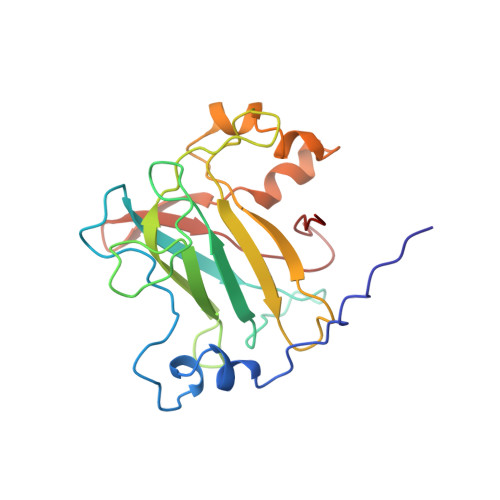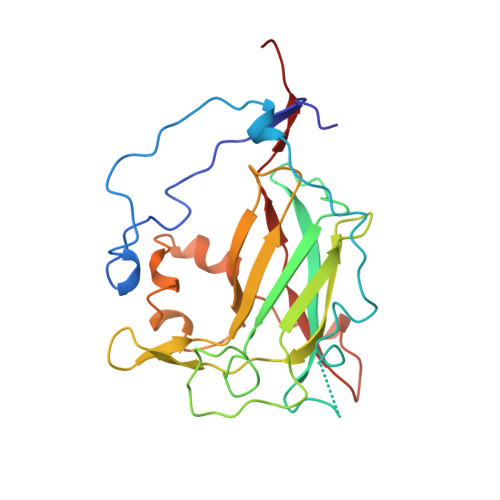The axial tyrosinate Fe3+ ligand in protocatechuate 3,4-dioxygenase influences substrate binding and product release: evidence for new reaction cycle intermediates.
Frazee, R.W., Orville, A.M., Dolbeare, K.B., Yu, H., Ohlendorf, D.H., Lipscomb, J.D.(1998) Biochemistry 37: 2131-2144
- PubMed: 9485360
- DOI: https://doi.org/10.1021/bi972047b
- Primary Citation of Related Structures:
3PCD - PubMed Abstract:
The essential active site Fe3+ of protocatechuate 3,4-dioxygenase [3, 4-PCD, subunit structure (alphabetaFe3+)12] is bound by axial ligands, Tyr447 (147beta) and His462 (162beta), and equatorial ligands, Tyr408 (108beta), His460 (160beta), and a solvent OH- (Wat827). Recent X-ray crystallographic studies have shown that Tyr447 is dissociated from the Fe3+ in the anaerobic 3,4-PCD complex with protocatechuate (PCA) [Orville, A. M., Lipscomb, J. D., and Ohlendorf, D. H. (1997) Biochemistry 36, 10052-10066]. The importance of Tyr447 to catalysis is investigated here by site-directed mutation of this residue to His (Y447H), the first such mutation reported for an aromatic ring cleavage dioxygenase containing Fe3+. The crystal structure of Y447H (2.1 A resolution, R-factor of 0.181) is essentially unchanged from that of the native enzyme outside of the active site region. The side chain position of His447 is stabilized by a His447(N)delta1-Pro448(O) hydrogen bond, placing the Nepsilon2 atom of His447 out of bonding distance of the iron ( approximately 4.3 A). Wat827 appears to be replaced by a CO32-, thereby retaining the overall charge neutrality and coordination number of the Fe3+ center. Quantitative metal and amino acid analysis shows that Y447H binds Fe3+ in approximately 10 of the 12 active sites of 3,4-PCD, but its kcat is nearly 600-fold lower than that of the native enzyme. Single-turnover kinetic analysis of the Y447H-catalyzed reaction reveals that slow substrate binding accounts for the decreased kcat. Three new kinetically competent intermediates in this process are revealed. Similarly, the product dissociation from Y447H is slow and occurs in two resolved steps, including a previously unreported intermediate. The final E.PCA complex (ES4) and the putative E.product complex (ESO2*) are found to have optical spectra that are indistinguishable from those of the analogous intermediates of the wild-type enzyme cycle, while all of the other observed intermediates have novel spectra. Once the E.S complex is formed, reaction with O2 is fast. These results suggest that dissociation of Tyr447 occurs during turnover of 3,4-PCD and is important in the substrate binding and product release processes. Once Tyr447 is removed from the Fe3+ in the final E.PCA complex by either dissociation or mutagenesis, the O2 attack and insertion steps proceed efficiently, suggesting that Tyr447 does not have a large role in this phase of the reaction. This study demonstrates a novel role for Tyr in a biological system and allows evaluation and refinement of the proposed Fe3+ dioxygenase mechanism.
Organizational Affiliation:
Department of Biochemistry, Medical School, and Center for Metals in Biocatalysis, University of Minnesota, Minneapolis, Minnesota 55455, USA.


















